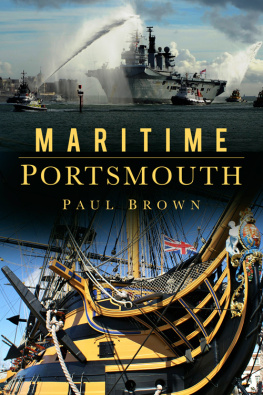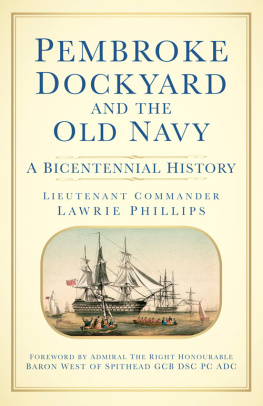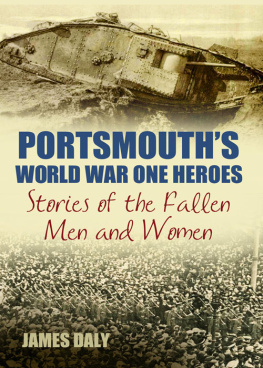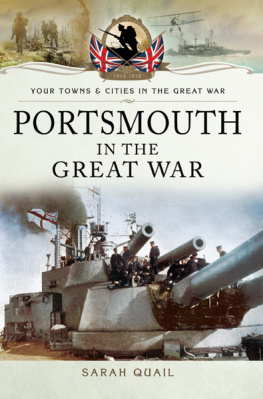


CONTENTS
T he maritime heritage of Portsmouth is described and celebrated in this book, and this new edition has been updated and revised to reflect all recent developments. For the past 300 years the port has been the leading base of the Royal Navy, but its origins as a military harbour date back to Roman times when Portchester was first fortified. Since the time of Henry I, expeditions have sailed from Portsmouth to wage naval and military campaigns in France, Spain and much further afield. Henry VIII established a permanent naval dockyard there and from the Napoleonic era onwards Portsmouth was the navys most important dockyard and base. Portsmouths history is thus inextricably entwined with the history of the Royal Navy and with some of the most momentous events in the history of the British Isles.

On 4 August 1960 Britains last battleship, Vanguard , was being towed by dockyard tugs out of the harbour to be handed over to Royal Fleet Auxiliary tugs at Spithead for her final journey to ship breakers. However, as this picture shows, she veered off course and ran aground close to Old Portsmouths Customs House Jetty on an ebbing tide. The dockyard tugs struggled but failed to free her and the larger RFA tugs had to be called to assist, it taking well over an hour to eventually free her.
The naval heritage of Portsmouth is manifested in the fortifications, buildings, docks and preserved ships described in this book. At Portchester are the 2,000-year-old Roman walls, whilst the Round Tower in its present form dates from about 1494 shortly before the building of the Mary Rose . Portsmouth vies with Chatham as the best-preserved Georgian dockyard in the world. The original Georgian buildings survive and look much as they did in Nelsons time, though their functions have, in many cases, changed. Within this setting is found the most illustrious survivor from the sailing navy, HMS Victory . This combination of a fully restored ship-of-the-line in its contemporary naval dockyard is unparalleled and is the citys greatest attraction. The Victorian buildings that accompanied the navys transition from sail to steam are also mostly intact, and in good condition. As if that were not enough, all this is seen alongside the modern Royal Navy and its facilities allowing fascinating comparisons to be made which illustrate the development of the navy and its ships over 300 years.
That this much has been preserved is something to be grateful for. Fortunately recent plans to convert many of the older buildings for residential and commercial use have been dropped. Parts of the historic dockyard, particularly redundant buildings, are still at risk. It would be far better to convert them into exhibition space (for related naval and maritime exhibits and museums) and even restore some of them to their original working facility so that they would become enhanced visitor attractions. There are lessons to be learnt from some developments of this sort which have increased the heritage and tourism appeal of Chatham Historic Dockyard. Access to many parts of Portsmouth Dockyard is currently prohibited except on such rare occasions as the International Festival of the Sea and needs to be improved. The tighter security introduced since the events of September 2001 has meant that only the immediate area between the Victory Gate (formerly known as the Main Gate) and HMS Victory is normally accessible.
During the eighteenth and nineteenth centuries, Portsmouth Royal Dockyard was the greatest industrial complex in the world. Whilst the buildings have by and large survived, ships are, by nature, ephemeral often with only short operational lives. Most of the famous ships that have featured in Portsmouths history have long since been broken up. Over the last thirty years or so there has been an awakening of interest in the preservation of the few historic ships that survive. As a result, at Portsmouth in addition to the Victory we can see an early Victorian battleship, a monitor from the First World War and the Royal Navys first submarine. There is, as yet, no significant survivor from the Second World War at the port. The submarine Alliance comes close to this, but, although designed during the war, she was not completed until after the end of hostilities and was heavily modernised in the 1950s. The best surviving British warship from the Second World War is HMS Belfast , which is moored near Tower Bridge in London.
The attraction of Portsmouths maritime heritage has been recognised and capitalised on by the local tourism industry. The creation of the National Museum of the Royal Navy integrating the Royal Marines Museum, Submarine Museum, Explosion Museum of Naval Firepower and HMS Victory , as well as the Royal Naval Museum into its operations has already led to an improved experience for visitors. The harbour also remains one of the countrys busiest, thanks in part to the growth of the ferry activity. Meanwhile, the navy continues to contract, through both relentless salami-slicing and the more drastic cuts of periodic defence reviews. This adversely affects the economy of Portsmouth and slowly erodes the spectacle of the modern navy there. The decision to base the two large new aircraft carriers at Portsmouth has hopefully stabilised the future of the base. Yet we should welcome the fact that, by and large, the contraction in size of the navy and its support facilities has only been possible because of the absence of major wars in the last sixty years. In 1946, the navy had almost 500,000 personnel. In 1947 de-mobilisation had reduced this to 192,665 and now the overall strength of the navy is about 30,000 personnel. The operational capability of the Royal Navy is now quite limited, meaning that there is greater reliance than ever before on our defence alliances with other nations. Each war fought since the Second World War has been confined to a single theatre, has been of fairly short duration and (with the exception of the Falklands War) has been fought with the USA as the main alliance partner. Hopefully, these circumstances, and the absence of major conflicts, means that we will no longer have to send an entire generation to war: instead they can join us as we enjoy all that the maritime heritage of Portsmouth has to offer.

A view of Portsmouth Harbour from Gosport in 1905. On the left are two Gosport ferries, whilst in the centre is the floating bridge which linked Gosport to Old Portsmouth and to the right is the depot ship for submarines, HMS Dolphin . (Simply Novel)

An artists impression of King Johns Dock in 1212. It was from here in 1213 that King Johns Royal Fleet of galleys joined more galleys from the Cinque Ports to achieve the first great naval victory over the French at the Battle of the Damme. Building of the dock had been instigated by King Richard I, who needed an alternative port to Southampton to be free of the powerful merchants and their high taxes. He needed a harbour for his royal ships, the warships of the small fleet that travelled between England and his possessions in France. This was the birth of the future City of Portsmouth, which grew from a small fishing hamlet into a town with a Royal Charter in 1194, and over the centuries became the cradle of the navy the premier naval base. (Rob Kennedy; caption courtesy of John Bingeman)
Next page
















